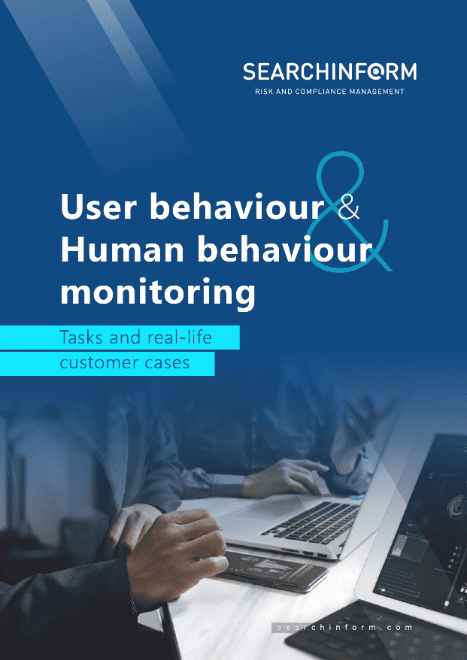Insider Threat Indicators: Unveiling the Invisible Risks
- Introduction to Insider Threat Indicators
- Behavioral Insider Threat Indicators
- Changes in Behavior:
- Social Withdrawal and Isolation:
- Unexplained Lifestyle Changes:
- Resistance to Change and Increased Defensiveness:
- Technical Insider Threat Indicators
- Unusual Access Patterns:
- Abnormal Data Transfer Activities:
- Suspicious System Modifications:
- Covert Communication Channels:
- Mitigation Strategies
- Behavioral Mitigation Strategies
- 1. Employee Awareness and Training:
- 2. Encourage Reporting and Whistleblowing:
- 3. Regular Employee Monitoring and Evaluation:
- Technical Mitigation Strategies
- 1. Access Control and Least Privilege Principle:
- 2. Data Loss Prevention (DLP) Solutions:
- 3. Continuous Monitoring and Incident Response:
- SearchInform’s Solution for Insider Threat Detection
- 1. Advanced Behavioral Analysis:
- 2. Real-time Monitoring and Alerts:
- 3. Comprehensive Data Visibility:
- 4. Integration with Existing Security Infrastructure:
- 5. Customizable Policy Enforcement:
- 6. User-Friendly Interface and Reporting:
Introduction to Insider Threat Indicators
In the realm of cybersecurity, the focus often gravitates towards external threats, yet the dangers posed by insiders within an organization can be equally, if not more, concerning. Insiders possess intimate knowledge of systems, making them formidable adversaries when acting maliciously. Recognizing the indicators of insider threats is paramount for preemptive action and safeguarding sensitive assets.
In this discourse, we delve into the subtle cues and anomalies that may signify potential insider threats. From behavioral red flags to access and usage patterns, communication anomalies, and system irregularities, each aspect provides valuable insights for detecting and mitigating insider threats before they escalate. By understanding these indicators, organizations can fortify their defenses and protect against the vulnerabilities posed by insiders.
Behavioral Insider Threat Indicators
In the realm of behavioral indicators, insider threats often manifest through subtle shifts in attitude and conduct. These can range from sudden displays of defensiveness or withdrawal to unexplained changes in lifestyle or financial habits. Disgruntled employees may exhibit increased negativity or resentment towards the organization, while those facing personal or financial hardships might succumb to external pressures. Additionally, individuals suddenly flaunting wealth or experiencing a drastic shift in behavior patterns might warrant closer scrutiny.
Changes in Behavior:
One of the most significant indicators of potential insider threats lies in the observation of changes in employee behavior. These alterations can range from subtle nuances to more overt shifts that may raise suspicions. For instance, an employee who previously demonstrated strong dedication and enthusiasm for their work may suddenly exhibit signs of disinterest or detachment. Conversely, individuals who were once reserved may begin to display uncharacteristic assertiveness or aggressiveness in their interactions. Recognizing these deviations from established norms requires astute observation and an understanding of individual behavioral patterns.
Social Withdrawal and Isolation:
Insider threats may also manifest through social withdrawal and isolation exhibited by employees. Individuals who once actively participated in team activities or engaged in social interactions within the workplace may gradually retreat into isolation. They may avoid team meetings, social gatherings, or collaborative projects, preferring instead to work alone and minimize interactions with colleagues. This withdrawal from social interactions can serve as a warning sign of potential insider threats, as it may indicate a desire to conceal illicit activities or avoid detection.
Unexplained Lifestyle Changes:
Another behavioral indicator of insider threats involves unexplained lifestyle changes exhibited by employees. These changes can manifest in various forms, such as sudden displays of wealth, extravagant spending habits, or unexplained absences from work. Employees who begin to exhibit a lifestyle that appears incongruent with their known income or job position may be engaging in activities that involve illicit gains. Additionally, unexplained absences or frequent requests for time off without valid reasons could signal attempts to conceal involvement in unauthorized activities outside the workplace.
Resistance to Change and Increased Defensiveness:
Resistance to organizational changes and increased defensiveness in response to inquiries or feedback can also be indicative of potential insider threats. Employees who vehemently oppose changes to established procedures, systems, or policies may have vested interests in maintaining the status quo to facilitate their illicit activities. Moreover, individuals who become defensive or hostile when questioned about their work or behavior may be attempting to deflect suspicion or avoid accountability for their actions. Recognizing these behavioral cues requires attentive leadership and a willingness to address underlying issues in a constructive manner.
By vigilantly monitoring changes in employee behavior and fostering a culture of transparency and accountability, organizations can enhance their ability to detect and mitigate insider threats effectively. Encouraging open communication channels, providing avenues for reporting concerns, and conducting regular assessments of employee well-being can contribute to a proactive approach to identifying and addressing potential insider threats before they escalate.
Technical Insider Threat Indicators
On the technical front, insider threats leave distinct traces within organizational systems and networks. Unauthorized access to sensitive data, particularly beyond an employee's usual scope, is a telltale sign of potential malfeasance. Similarly, abnormal usage patterns such as frequent access during off-hours or large-scale data transfers to external locations could indicate data exfiltration attempts. Furthermore, anomalies within system configurations, unauthorized software installations, or attempts to bypass security protocols underscore the technical sophistication employed by insider threats.
Its discovery entails:
Unusual Access Patterns:
Anomalies in access patterns across organizational systems and networks can serve as significant indicators of insider threats. For instance, employees accessing sensitive information or critical systems beyond their usual job roles or during non-standard hours may be engaging in unauthorized activities. Monitoring access logs and establishing baseline access patterns can help detect deviations indicative of potential insider threats, prompting further investigation and mitigation efforts.
Abnormal Data Transfer Activities:
Monitoring data transfer activities within the organization's network can reveal potential insider threats attempting to exfiltrate sensitive information. Large-scale data transfers to external destinations or unauthorized cloud storage services without proper authorization may signify attempts to steal or compromise valuable data assets. Implementing data loss prevention (DLP) solutions and network monitoring tools can help detect and prevent unauthorized data transfers, thereby mitigating the risks posed by insider threats.
Suspicious System Modifications:
Unauthorized modifications to system configurations or security settings can indicate insider threats attempting to exploit vulnerabilities or gain unauthorized access. For example, the installation of unapproved software or tools, changes to firewall rules, or alterations to user privileges without proper authorization may signal attempts to bypass security controls. Regularly auditing system configurations and implementing change management procedures can help detect and prevent unauthorized modifications, reducing the likelihood of insider threats compromising system integrity.
Covert Communication Channels:
Insider threats may employ covert communication channels to conceal their activities and coordinate illicit actions. For instance, the use of encrypted or obfuscated communication protocols, such as encrypted emails or messaging apps, may indicate attempts to evade detection. Monitoring network traffic for suspicious communication patterns and implementing intrusion detection systems (IDS) or data leakage prevention (DLP) solutions can help identify and block covert communication channels used by insider threats, thereby enhancing the organization's security posture.
By actively monitoring for these technical indicators of insider threats and implementing appropriate security controls and detection mechanisms, organizations can enhance their ability to detect and mitigate internal security risks effectively. Additionally, fostering a culture of security awareness and promoting adherence to established security policies and procedures can help mitigate the human factors contributing to insider threats, further strengthening the organization's defenses against internal threats.
Mitigation Strategies
Implementing effective mitigation strategies is essential for organizations seeking to minimize the risks posed by insider threats. By adopting proactive measures, organizations can enhance their security posture and protect sensitive information and assets from potential harm. This section explores various mitigation strategies aimed at addressing both behavioral and technical aspects of insider threats.

Behavioral Mitigation Strategies
1. Employee Awareness and Training:
Educating employees about the risks associated with insider threats and providing training on identifying suspicious behaviors can empower them to act as the first line of defense. By raising awareness about the potential consequences of insider threats and promoting a culture of vigilance, organizations can enlist the support of employees in mitigating internal security risks.
2. Encourage Reporting and Whistleblowing:
Establishing clear reporting channels and encouraging employees to report any suspicious activities or concerns can help organizations identify and address insider threats promptly. Creating a supportive environment where employees feel comfortable reporting concerns without fear of reprisal is essential for fostering transparency and accountability.
3. Regular Employee Monitoring and Evaluation:
Regular monitoring of employee behavior and performance can help identify early warning signs of potential insider threats. By conducting periodic evaluations and assessments, organizations can detect deviations from established norms and intervene before they escalate into security incidents. However, it's crucial to balance monitoring efforts with employee privacy rights and ethical considerations.
Technical Mitigation Strategies
1. Access Control and Least Privilege Principle:
Implementing robust access control measures based on the principle of least privilege can limit the exposure of sensitive information to only those employees who require it to perform their job duties. By restricting access to critical systems and data repositories based on job roles and responsibilities, organizations can minimize the opportunities for insider threats to exploit vulnerabilities.
2. Data Loss Prevention (DLP) Solutions:
Deploying data loss prevention (DLP) solutions can help organizations monitor and control the flow of sensitive information within the network. Our solutions can detect and prevent unauthorized data transfers, whether intentional or accidental, thereby mitigating the risks of data exfiltration by insider threats. Implementing encryption and data masking techniques can further protect sensitive data from unauthorized access.
3. Continuous Monitoring and Incident Response:
Implementing continuous monitoring solutions, such as intrusion detection systems (IDS) and security information and event management (SIEM) platforms, can help organizations detect and respond to insider threats in real-time. By monitoring network traffic, system logs, and user activities for anomalous behavior, organizations can identify potential security incidents and initiate timely incident response actions to mitigate the impact.
Mitigating insider threats requires a comprehensive approach that addresses both behavioral and technical aspects of security. By combining employee awareness and training initiatives with robust technical controls and continuous monitoring solutions, organizations can enhance their ability to detect, prevent, and respond to insider threats effectively. Moreover, fostering a culture of security awareness and promoting ethical behavior among employees can serve as a proactive defense against insider threats, ensuring the protection of sensitive information and organizational assets.
SearchInform’s Solution for Insider Threat Detection
SearchInform offers comprehensive solutions designed to detect and mitigate insider threats effectively. With advanced technologies and innovative approaches, SearchInform's solutions provide numerous benefits for organizations seeking to enhance their security posture and safeguard against internal risks.
1. Advanced Behavioral Analysis:
SearchInform's solutions leverage advanced behavioral analysis techniques to detect subtle deviations in employee behavior that may indicate insider threats. By analyzing patterns of activity and interactions, our solutions can identify suspicious behavior in real-time, enabling organizations to intervene proactively before security incidents occur.
2. Real-time Monitoring and Alerts:
SearchInform's solutions provide real-time monitoring capabilities, allowing organizations to track employee activities across digital channels and systems. Automated alerts are triggered in response to anomalous behavior or policy violations, enabling security teams to respond swiftly to potential insider threats and mitigate risks before they escalate.
3. Comprehensive Data Visibility:
SearchInform's solutions offer comprehensive visibility into organizational data, including sensitive information and intellectual property. By monitoring data access and usage patterns, our solutions enable organizations to identify unauthorized activities and prevent data exfiltration by insider threats, thereby protecting valuable assets and maintaining regulatory compliance.
4. Integration with Existing Security Infrastructure:
SearchInform's solutions seamlessly integrate with existing security infrastructure, including SIEM platforms, DLP solutions, and endpoint security tools. This interoperability enhances the effectiveness of insider threat detection and response efforts, enabling organizations to leverage their existing investments in security technologies.
5. Customizable Policy Enforcement:
SearchInform's solutions allow organizations to define and enforce customizable security policies tailored to their specific needs and regulatory requirements. By establishing granular access controls and behavior-based rules, organizations can mitigate insider threats while minimizing false positives and disruptions to legitimate business activities.
6. User-Friendly Interface and Reporting:
SearchInform's solutions feature intuitive user interfaces and comprehensive reporting capabilities, making it easy for security teams to analyze and visualize insider threat data. Detailed reports and dashboards provide actionable insights into insider threat trends, enabling organizations to make informed decisions and prioritize response efforts effectively.
SearchInform's solutions offer a range of benefits for organizations seeking to detect and mitigate insider threats. From advanced behavioral analysis and real-time monitoring to comprehensive data visibility and customizable policy enforcement, our solutions empower organizations to enhance their security posture and protect against internal risks effectively.
Ready to fortify your organization's defenses against insider threats? Take proactive steps today with SearchInform's advanced solutions, empowering you to detect, mitigate, and prevent internal risks effectively. Don't wait for a breach to occur – safeguard your sensitive assets and maintain peace of mind with SearchInform.
Full-featured software with no restrictions
on users or functionality
Company news
SearchInform uses four types of cookies as described below. You can decide which categories of cookies you wish to accept to improve your experience on our website. To learn more about the cookies we use on our site, please read our Cookie Policy.
Necessary Cookies
Always active. These cookies are essential to our website working effectively.
Cookies does not collect personal information. You can disable the cookie files
record
on the Internet Settings tab in your browser.
Functional Cookies
These cookies allow SearchInform to provide enhanced functionality and personalization, such as remembering the language you choose to interact with the website.
Performance Cookies
These cookies enable SearchInform to understand what information is the most valuable to you, so we can improve our services and website.
Third-party Cookies
These cookies are created by other resources to allow our website to embed content from other websites, for example, images, ads, and text.
Please enable Functional Cookies
You have disabled the Functional Cookies.
To complete the form and get in touch with us, you need to enable Functional Cookies.
Otherwise the form cannot be sent to us.

Subscribe to our newsletter and receive a bright and useful tutorial Explaining Information Security in 4 steps!

Subscribe to our newsletter and receive case studies in comics!







